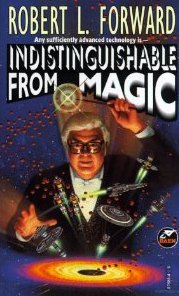Robert Forward’s Indistinguishable from Magic is a genial and absorbing read, a collection of essays and fiction illustrating some of the scientist’s most memorable ideas. And while gigantic lightsails driven by laser beam to other stars always come to mind when Forward’s name is mentioned, it’s fascinating to page through his thoughts on antimatter, black holes and time machines. Long a Forward admirer, I was pleased to see that another of the concepts discussed in this book recently made an appearance at this month’s solar sail conference in Brooklyn.
‘Statites’ are a Forward construct, a word he coined to describe a spacecraft that uses a solar sail to hover over a region rather than orbiting the Earth. Let Forward describe what he calls a ‘technique for hanging things in the sky’:
…I have the patent on it — U.S. Patent 5,183,225 “Statite: Spacecraft That Utilizes Light Pressure and Method of Use”… The unique concept described in the patent is to attach a television broadcast or weather surveillance spacecraft to a large highly reflective lightsail, and place the spacecraft over the polar regions of the Earth with the sail tilted so the light pressure from the sunlight reflecting off the lightsail is exactly equal and opposite to the gravity pull of the Earth.
You can see where Forward is going with this. This is a solar sail that isn’t designed for transport but for station-keeping, and it offers options that other kinds of satellite do not. But maybe satellite is the wrong word:
With the gravity pull nullified, the spacecraft will just hover over the polar region, while the Earth spins around underneath it. Since the spacecraft is not in orbit around the Earth, it is technically not a satellite, so I coined the generic term ‘statite’ or ‘-stat’ to describe any sort of non-orbiting spacecraft (such as a ‘weatherstat’ or ‘videostat’ or ‘datastat’).
Forward always noted that he had made no money from his patent, but said he didn’t want to make the mistake Arthur C. Clarke did when he failed to obtain a patent on his idea of the geosynchronous communications satellite. In a short story included in Indistinguishable from Magic called ‘Race to the Pole,’ Forward writes about a statite called the ‘Hovering Hawke’ that uses a kilometers wide square lightsail to support a powerful broadcast satellite. Such a ‘polesitter’ would, by Forward’s calculations, need to be too distant to serve as a communications satellite, but direct broadcast or weather surveillance would be robust applications.
Just how distant would a polesitter have to be? In this passage from the story, a scientist explains the difficulty a statite would experience maintaining a stable position as the Earth’s seasons change:
“The control problem of keeping the [statite] balanced over the pole is very tricky, especially during the summer season of that hemisphere when the polar axis is over on the sunlit side of the Earth. That’s why ‘pole-sitters’ have to be placed so far away from the Earth. If they get any closer than 250 Earth radii, they become unstable during the summer.”

Forward’s patent ran out in February of this year, but his idea is beginning to gain traction. At the Second International Symposium on Solar Sailing, which ended just last week, Matteo Ceriotti reported on work with Colin McInnes describing what Forward called ‘displaced orbits’ that would allow geosynchronous telecommunications satellites to be deployed to the north or south of the Earth’s equator. Working with graduate student Shahid Baig, McInnes (University of Strathclyde) has published a new paper that shows the viability of displaced orbits. Says McInnes:
“Satellites generally follow Keplerian Orbits, named after Johannes Kepler – the scientist who helped us understand orbital motion 400 years ago. Once it’s launched, an unpowered satellite will ‘glide’ along a natural Keplerian orbit. However, we have devised families of closed, non-Keplerian orbits, which do not obey the usual laws of orbital motion. Families of these orbits circle the Earth every 24 hours, but are displaced north or south of the Earth’s equator. The pressure from sunlight reflecting off a solar sail can push the satellite above or below geostationary orbit, while also displacing the centre of the orbit behind the Earth slightly, away from the Sun.”
Image: Analog‘s December, 1990 issue contained an article by Robert Forward describing the ‘polesitter’ concept, one of many innovative ideas the scientist introduced to a broad audience. Credit: Condé Nast.
No, we’re not in ‘polesitter’ range, not yet, anyway. But these displaced orbits would allow solar sails — McInnes is interested in hybrid sails complemented by electric propulsion systems — to be displaced between 10 and 50 kilometers from the equator. As we continue our work with solar sails, finding ways to make them robust enough to handle polar stationary orbits seems like a reasonable expectation. Another Forward concept thus moves into sharper definition. I can only imagine how much the late Dr. Forward would have enjoyed sitting in on the relevant session at the solar sail conference, and reading the McInnes paper.
The paper is Baig and McInnes, “Light-Levitated Geostationary Cylindrical Orbits are Feasible,” Journal of Guidance, Control and Dynamics, Vol. 33, No. 3 (2010), pp. 782-793 (preprint). You’ll also enjoy reading the non-fiction piece Robert Forward wrote for Analog. It’s “Polesitters,” published in Analog Science Fiction/Science Fact Vol. 110, No. 13 (December, 1990), pp. 88-94.




It’s a really cool idea, and I am a huge Robert Forward fan.
however, I really don’t believe someone should be allowed to patent something without showing the capability to build it. Arthur C. Clarke for instance didn’t patent the geo-sync satellite, and we have lots. How much worse off would we be if he’d been a money grubber who only licenced them to the highest bidder, and we now had 4 or 5 because that was how he made most money?
Just a thought
250 Earth radii is 1.5 million km, way further than the moon. Seems not nearly as useful an orbit as GEO or the Lagrange points.
Not to detract from Forward’s genius, though, I am a fan myself.
I think patents last 20 or 25 years. So, given the snail pace of space things, a lot of them will be expired by the time one gets around to use them.
This is particularly true for grandiose schemes well ahead of their time.
One of the conditions for a patent is “enablement”. The description should enable “those with ordinary skill in the art” to “practice the invention”. That would seem very difficult if the inventor him- or herself has never “practiced the invention”. Maybe I am misunderstanding, but it indeed seems that Mark is right and this type of patent should not be granted. Nevertheless, you can find quite a lot of issued ones. I find this one is particularly interesting: http://www.patentstorm.us/patents/6311926/fulltext.html
Hi Paul
Love that book. My local library had a copy but then sold it off as an ‘old book’ when I wasn’t there to snatch it for a bargain price. C’est la vie.
Adam, if you haven’t already bought a used copy elsewhere, very cheap (including postage) copies of “Indistinguishable From Magic” are available from numerous AbeBooks.com-affiliated booksellers (see: http://www.abebooks.com/servlet/SearchResults?an=Forward&sts=t&tn=Indistinguishable+from+Magic&x=82&y=13 ).
— Jason
“Indistinguishable from Magic” is available as an ebook download dirt cheap from Baen Books too.
http://www.webscription.net/chapters/0671876864/0671876864.htm?blurb